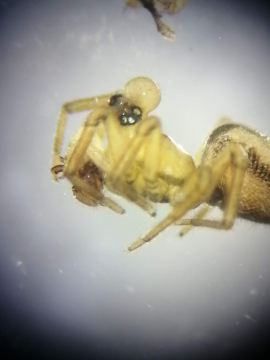Summary for Minicia marginella (Araneae)
previous species | next species
National Distribution
Terms of Use. Double-click on map to go to region

Explore Regional Distribution
Please log on and add a note on this species
About this species
Recorded altitude range6m to 285m
Species text
DistributionThe species was discovered in Britain in 1987 at Shakespeare Cliff near Dover. It is widespread though seldom common throughout central and northern Europe as far north as northern Fennoscandia, but seems to be absent from most of the Mediterranean region.
Habitat and ecology
The spiders were taken among samples of invertebrates from an old rock fall at the base of the cliff. The site comprises a small area of moderately sloping chalk grassland dominated by Brachypodium pinnatum and Festuca rubra. In Europe it is most commonly found in dry habitats, among dead leaves, fallen pine needles, moss, and on sand dunes, but may also be found climbing on tall herbs and shrubs such as broom, tamarisk, gorse and juniper. It has also been taken in wet areas such as marshes. Both the original British specimens were collected in pitfall traps set between 27th May and 24th June.
Status
The spider has only been found at one site in Britain. A male and female were collected in pitfall traps in 1987, and several of the easily recognizable immatures were seen in early June 1991. The spider has not been collected in Britain since that date, an apparent decline of 100% in the number of locations from which it has been recorded.
Threats
The species was discovered during an extensive invertebrate survey of several sites around Dover and Folkestone as part of a study of the ecological impact of the engineering work for the Channel Tunnel. It is not known how the construction of the Channel Tunnel has affected the population of this species, but recent fieldwork in the area has not recorded the species. If it is restricted to such a small, rather vulnerable area it must be under considerable threat. The main threat to the location itself may, in the long term, be sea level rise and increased wave action
Management and conservation
Too little is known of the habitat and other ecological requirements of this species in Britain to be able to make management recommendations.
Text based on Dawson, I.K., Harvey, P.R., Merrett, P. & Russell-Smith, A.R. (in prep.). References
Adult Season
Habitats
background methodology
Recorded management for locations with Minicia marginella
Recorded substrate and hydrology for locations with Minicia marginella
Images
please log on and upload a new image for this speciesSee also A-Z Species Index - A-Z Picture Index - previous species | next species
